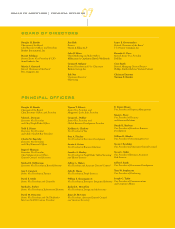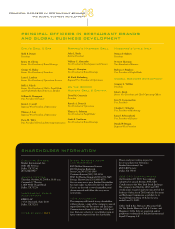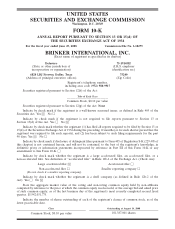Chili's 2008 Annual Report Download - page 19
Download and view the complete annual report
Please find page 19 of the 2008 Chili's annual report below. You can navigate through the pages in the report by either clicking on the pages listed below, or by using the keyword search tool below to find specific information within the annual report.preparation of brand-formulated recipes. Routine visitation to the restaurants by all levels of supervision
enforces strict adherence to our overall brand standards and operating procedures.
Each brand is responsible for maintaining each brand’s operational training program. The training
program typically includes a three to four month training period for restaurant management trainees, a
continuing management training process for managers and supervisors, and training teams consisting of
groups of team members experienced in all facets of restaurant operations that train team members to
open new restaurants. The training teams typically begin on-site training at a new restaurant seven to ten
days prior to opening and remain on location one to two weeks following the opening to ensure the smooth
transition to operating personnel.
Purchasing
Our ability to maintain consistent quality throughout each of our restaurant brands depends upon
acquiring products from reliable sources. Our pre-approved suppliers and our restaurants are required to
adhere to strict product specifications established through our quality assurance and culinary programs.
These requirements ensure that high quality products are served in each of our restaurants. We
strategically negotiate directly with major suppliers to obtain competitive prices. We also use purchase
commitment contracts to stabilize the potentially volatile pricing associated with certain commodity items.
All essential products are available from pre-qualified distributors to be delivered to any of our restaurant
brands. Additionally, as a purchaser of a variety of protein products, we do require our vendors to adhere
to humane processing standards for their respective industries. Because of the relatively rapid turnover of
perishable food products, inventories in the restaurants, consisting primarily of food, beverages and
supplies, have a modest aggregate dollar value in relation to revenues.
Advertising and Marketing
Our brands generally focus on the eighteen to fifty-four year-old age group, which constitutes
approximately half of the United States population. Though members of this target segment grew up on
fast food, we believe that for many meal occasions, these consumers value the benefits of the casual dining
category, particularly the higher food quality and enhanced dining experience. To reach this target group,
we use a mix of television, radio, print or online advertising, with each of our restaurant brands utilizing
one or more of these mediums to meet the brand’s communication strategy and budget.
Our franchise agreements require advertising contributions to us by the franchisees. We use these
contributions exclusively for the purpose of obtaining consumer insights, developing and producing brand-
specific creative materials and purchasing national or regional media to meet the brand’s strategy. Some
franchisees also spend additional amounts on local advertising. Any such local advertising must first be
approved by us.
Team Members
At June 25, 2008, we employed approximately 100,400 persons, of whom approximately 1,000 were
restaurant support center personnel, 5,900 were restaurant area directors, managers or trainees and 93,500
were employed in non-management restaurant positions. Our executive officers have an average of
approximately 23 years of experience in the restaurant industry.
We consider our team member relations to be positive and continue to focus on improving our team
member turnover rate. We use various tools and programs to help us hire our new team members. We
utilize tools that aid in determining if our prospective team members (hourly and management) have the
proper skills for working at our restaurants. Most team members, other than restaurant management and
restaurant support center personnel, are paid on an hourly basis. We believe that we provide working
conditions and wages that compare favorably with those of our competition. Our team members are not
covered by any collective bargaining agreements.
7
























